
If you have seen artwork displayed in a home, gallery, office, or other type of location, you may have noticed how much lighting impacts the presentation. Lighting artwork properly is essential to experience and understand the complete work of art and all of its illustrious detail. Artwork comes in a great variety of shapes and sizes, including two–dimensional art such as paintings and photographs and three–dimensional art featuring sculptures and carvings.
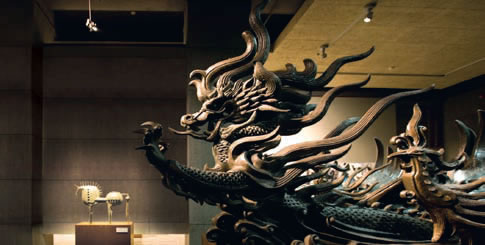
Lighting artwork poses challenges from both the technical application and design aspects. Proper lighting can bring out nuances and effects in your artwork that you may have not seen previously in a different light.
Utilizing the correct lighting fixtures and lamping will help distinguish your artwork in a room or environment. Considerations for ambient lighting, color temperatures, color rendering and lamp positioning are a few of the techniques and styles that we will explore.
Artwork comes in a variety of shapes, sizes and types. This Application Note was created to help new and existing art owners light their pieces successfully and with style. WAC Lighting focuses on both residential and commercial applications and offers unique products to fill your individual needs. We also understand that those needs vary depending on the application and the intended look of the artwork itself.
In lighting design, lighting artwork properly helps to create a dramatic, subtle or surreal effect in your room or environment. Consider not just the piece, but how the piece is represented in the surrounding space. There are many different lighting and lamping sources available on the market today and it is important to understand your specific application and the surrounding environment before we explore how to maximize its effectiveness with lighting.
There are some general rules of
thumb to follow when lighting artwork, although applied
techniques can vary for unique style considerations.
Without light we will not be able to see the artwork.
With poor lighting, it will be difficult for us to
be pleased in viewing the artwork. When applying the
techniques 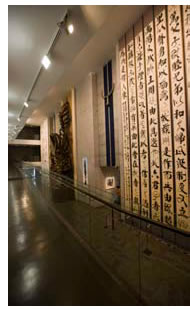 discussed herein consider the overall lighting
design and going beyond just lighting the piece of
artwork to maximize its effectiveness and visual appeal.
discussed herein consider the overall lighting
design and going beyond just lighting the piece of
artwork to maximize its effectiveness and visual appeal.
Han Meilin is one of the world's most renowned artists and is responsible for many significant works around the world. Recently constructed is the Beijing Han Meilin Art Museum, which is a personal art museum that holds the richest kinds of art categories and the largest quantity of exhibits. The lighting designer chose WAC Lighting as the primary source to highlight the exhibits and displays. In the museum, ambience is normally dimmed to highlight exhibits. The artist insists on bright environments. In lighting the artwork, the designer adopted cold light on the background and warm light on the exhibits. Carefully chosen lamps and lamp positions control vertical illumination to protect papery Chinese paintings and to avoid interference caused by mirror effects. (Right).
When creating your lighting plan, generally use a light source for your artwork that is three times the intensity (brightness) of the ambient (room) lighting. This helps to accent your piece without the light appearing too dim or overwhelming. In lighting design, techniques can also be applied to reduce the general lighting level within the space where the artwork is being displayed to achieve this 3:1 contrast. First, assign the light level that is appropriate to the artwork and then adjust the level for the rest of the room to create the right visual contrast. The two major types of artwork, 2-D and 3-D, both deserve the same lighting considerations however, techniques will vary. The viewing angles, shadows and reflections are different and unique to each piece of art. 3-D artwork can be accented, but 2-D artwork, in general, is lit evenly. Proper lighting needs to have a good balance of visual performance, energy conservation and preservation of the artwork. Visual performance requires different design considerations, to achieve a good balance of brightness and contrast while producing the optimal color rendering.
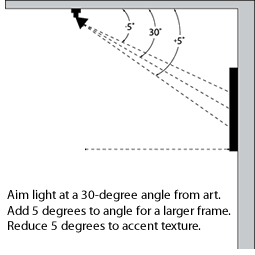 When
positioning your lighting in relation to the piece
of artwork consider several variables. To help reduce
glare, place the light at a 30-degree angle from the
piece. Add 5 degrees to the angle for a larger frame,
which helps to avoid casting a shadow. Reduce 5 degrees
from the position if you are trying to accent the texture
of a painting.
When
positioning your lighting in relation to the piece
of artwork consider several variables. To help reduce
glare, place the light at a 30-degree angle from the
piece. Add 5 degrees to the angle for a larger frame,
which helps to avoid casting a shadow. Reduce 5 degrees
from the position if you are trying to accent the texture
of a painting.
Some works of art have sensitivities to heat, Ultra Violet (UV) or Infrared (IR) radiation. These pieces should be kept out of direct or indirect sunlight and proper lamping options should be selected to best preserve them over time. To help alleviate this concern, WAC Lighting offers many lens options, including UV and IR blocking lenses to protect your artwork. For heat sensitive artwork, place the lamp at an adequate distance from the piece. Use your hand to test heat output between the lamp and the artwork. If an adequate distance cannot be achieved, select an alternative light source, like the WAC LEDme™ track lights; which are thermally energy efficient, long lasting and deliver a strong light output with color options available from warm white 3000K to cool white 6000K depending on the look you wish to achieve (below).

WAC Lighting offers many products to meet your artwork lighting needs. To help better understand which options are best for lighting your artwork, the benefits and applications for each are explained herein.
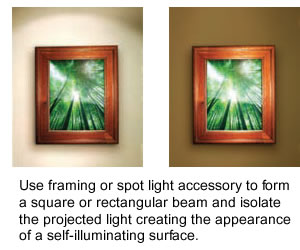 Halogen and other Lamping Options
Halogen and other Lamping Options Halogen Lighting is the most popular choice when it comes to lighting artwork when using track or recessed lighting in residential and commercial applications such as restaurants, hotel lobbies or establishments. Halogen Light has close to a 100 CRI (Color Rendering Index), which describes how a light source makes the color of an object appear to human eyes and how well subtle variations in color shades are revealed. CRI is measured on a scale of 0%-100%. In the case of lighting artwork, a higher CRI is generally preferred. WAC Lighting offers Halogen Track Lights with framing and spot light accessory options which have Adjustable metal shims to form square or rectangular beams (Right). This makes it possible to isolate the projected light within the four corners of a painting and creates the appearance of a self-illuminating surface. A variety of clear, colored or colored dichroic lenses are available to simulate special effects.
Framing Projector Picture Lights >
Incandescent and Fluorescent light can also be used to illuminate some pieces artwork, but it is not recommended. Incandescent light is typically less harmful than Fluorescent, especially un-shielded Fluorescent which emanates larger concentrations of UV radiation. Standard incandescent lamps can display too much warm white which creates an imbalanced shift. Incandescent bulbs also have a much shorter lamp life and can end up costing more than halogen or LEDs in re-lamping down the line. It is not recommended to use halogen light in a picture light that is mounted close to your artwork since halogen lamps project significant amounts of heat.
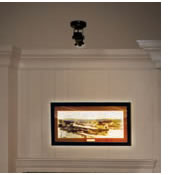 Surface Mount Spots
Surface Mount Spots WAC Lighting's Surface Mount Spots collection is a great choice for lighting artwork. The Surface Mount Spots can achieve accent or task lighting when surface mounting the fixture is the best option. They are available in low and line voltage versions in today's popular finishes, with a wide selection of designs and accessories including lens options and the framing projector. Extension are available from 6–96" to help bring the lighting for your artwork into the proper position.
WAC Lighting's Display Lighting collection includes low and line voltage versions, as well as LED fixtures in a number of finishes and styles to meet your unique lighting needs. Most fixtures can be easily adapted for Installation: in temporary or permanent displays. Know for their convenience and portability, Compact and Mini Picture Lights mount display lighting is preferred for office partitions, craft fairs and art shows, as well as residential applications. For example, energy efficient, low voltage Compact and Mini Picture Lights mount fixtures were used recently to illuminate wall decor in a bedroom of an award winning Green Home in Jericho, NY (below).
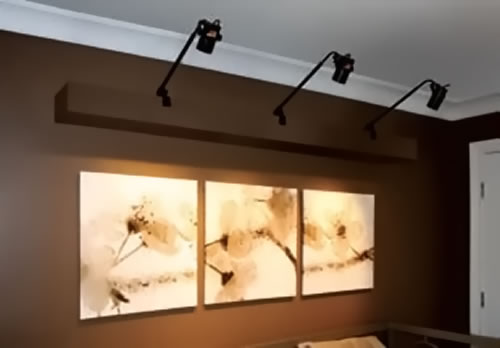
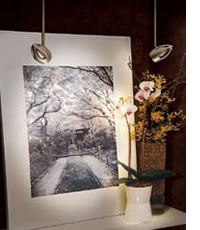 LEDme™ Track Lights
LEDme™ Track LightsLEDme™ Track Lights are the next generation in accent and display lighting fixtures. These track lights are thermally energy efficient, long lasting and deliver a strong light output. These fixtures are perfect for effective displays, high-end residential accent lighting and displays in museums, hotels and restaurants.
High quality LEDs deliver beams free of projected heat and ultraviolet radiation. Perfect for colored or heat sensitive artwork, these fixtures are available in 3000K warm white and 4500K cool white color temperatures. LED lights are the perfect substitute for halogen units when there is not enough distance between the fixture and the artwork to provide adequate cooling. For More Information on LED technology options and techniques, refer to the WAC LED technical paper available at www.waclighting.com under Product Literature.
Although it may be overwhelming when selecting the best lighting choice from the broad range of options and features, this application note was created to help you achieve your optimal lighting solutions for your artwork. In following the techniques and guidelines laid out above, we hope you are able to display your art in the best light possible. For professional guidance in challenging artwork lighting applications, consult a lighting designer for assistance.

design42 New Media Web Design
2192 Dartmouth Rd
Hendersonville NC 28791